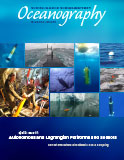First Paragraph
In an article on horizontal diffusion, Henry Stommel (1949) suggested using the recently discovered deep sound or SOFAR channel to track neutrally buoyant floats over hundreds of kilometers. This was an idea ahead of its time, but in 1965 he encouraged Douglas Webb to take a fresh look at the concept. This led in 1969 to the first successful demonstration tracking of a neutrally buoyant float in the deep sound channel for four months. Soon after, in 1973, 20 SOFAR floats were deployed to study mesoscale eddy motion in the Sargasso Sea. A major evolutionary step took place in 1984 with the development of the isopycnal RAFOS float, a glass pipe designed to listen to coded signals from moored sound sources. This approach brought down system cost substantially, and made it easy to conduct Lagrangian studies anywhere in the world (see Rossby, 2007, for a history of float technology). In a further expansion of this technology, Rossby (2016) shows how the Lagrangian method can help visualize flow patterns in the ocean.

